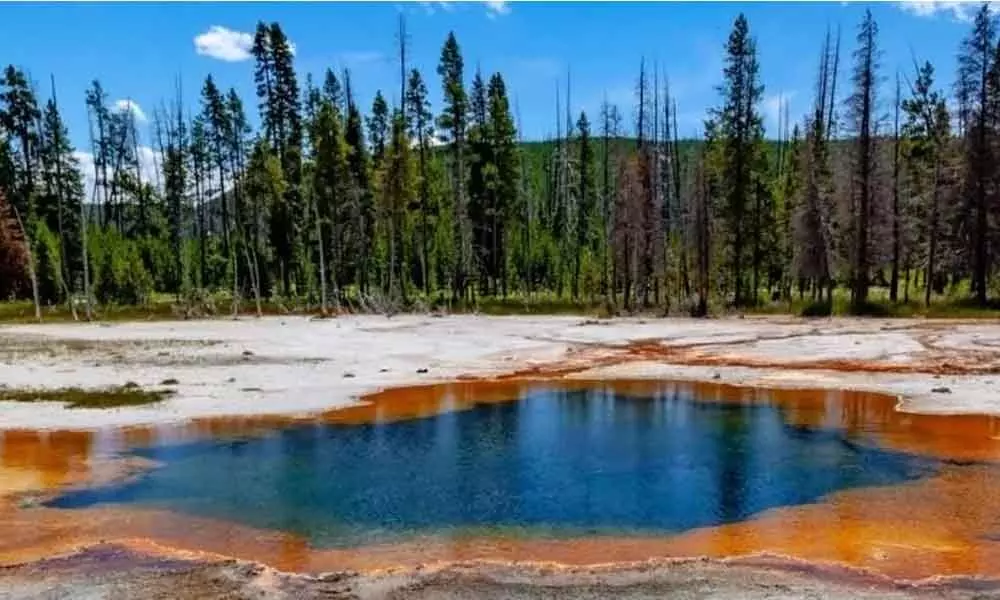Live
- They always want me to win, and now I feel lucky to have been offered a story like ‘Zebra’: Satyadev Kancharana
- ‘Democracy first, humanity first’: PM Modi in Guyana's parliament on two countries' similarities
- PKL Season 11: Telugu Titans register third straight win to top standings
- Is Pollution Contributing to Your COPD?
- NASA Unveils Underwater Robots for Exploring Jupiter's Moons
- Additional Central forces arrive in violence-hit Manipur
- AR Rahman and Saira Banu’s Divorce: Legal Insights into Common Issues in Bollywood Marriages
- 82.7 pc work completed in HPCL Rajasthan Refinery area: official
- Curfew relaxation extended in 5 Manipur districts on Friday
- Tab scam prompts Bengal govt to adopt caution over fund disbursement
Just In
Iron Might Played An Important Role In The Evolution Of Complex Life On Earth

Hans News Service | 7 Dec 2021 2:45 PM IST

x
Iron Might Played An Important Role In The Evolution
Highlights
- According to some experts, there's another element out there that's equally important to this evolutionary boom: iron.
- The availability of iron for life throughout the history of our planet, University of Oxford Earth scientist Jon Wade and colleagues argue that the metal's variations aided evolution on Earth.
Oxygen is a necessary component of life on Earth. Multicellular life on our planet began to thrive after a rise in this gas in the atmosphere about 2.5 billion years ago. According to some experts, there's another element out there that's equally important to this evolutionary boom: iron.
In a comprehensive analysis of the availability of iron for life throughout the history of our planet, University of Oxford Earth scientist Jon Wade and colleagues argue that the metal's variations aided evolution on Earth.
Iron is now a vital component of almost all living things. Cells use it to sense oxygen, create energy, replicate DNA, and express genes. In fact, only two creatures known to exist on our planet do not require this metal to survive.
There was plenty of geological iron to go around in the early days of the Earth, notably in the mantle and crust. The solid iron found here was most likely'seeded' by meteorites from space, and because it could dissolve in ancient oceans, iron was prevalent in the marine environment.
Conditions began to shift following the Great Oxidation Event (GOE). Soluble iron became limited, and cell competition for iron became fierce.
To stay alive, life-forms have to figure out how to recycle iron from dead cells, steal iron from living cells, or reside in another cell and use that cell's iron-grabbing mechanism.Some experts believe that it was these wars over iron that first initiated multicellular development.
Infection, predation, and endosymbiosis are all behaviours that shift the focus of iron acquisition from mineral sources to other life-forms. The authors explain, and each of the three behaviours may evolve into the others over time – for example, initially exploitative infections may become mutually symbiotic.
Older types of single-celled life, such as bacteria and Archaea, are assumed to have required more on iron to thrive than current eukaryotes, or multicellular organisms.
This shows that throughout millions of years, as the element's availability in the environment fluctuated, modern creatures learnt to utilise it more efficiently.
According to this new idea, an increase in atmospheric oxygen caused the seas to lose most of their soluble iron. When water and solid iron come into contact in the presence of oxygen, the iron quickly oxidises, making it more difficult for living beings to use.
To capture the element in this form, cells must evolve siderophores, which are tiny organic molecules. These structures are found in practically all bacteria, plants, and fungus now, yet billions of years ago, they were a novel way of surviving.
Researchers believe that as life-forms with siderophores began to congregate near a finite number of iron-rich geological sources, crowding ultimately resulted in increasingly intricate cell-cell interactions.
Archaea in Yellowstone's thermal springs, for example, can only survive on iron oxide mats. Modern eukaryotes, on the other hand, can survive outside of these geological sources as long as biological forms of iron are accessible.
Author wrote that despite the reduction of accessible iron, iron has kept its preeminence in biological systems throughout the rebound of life post-GOE and its subsequent diversification (and passage through other succeeding mass extinction events.
Because there is no substitute for iron, organisms had to compete, cheat, or cooperate to survive after the GOE, and these changes could have resulted in severe modifications in genomes and cellular behaviour throughout time.
The more recent Neoproterozoic Oxygenation event, which took place some 500 million years ago, only aggravated these alterations.
Thus, while an availability of iron may have aided the emergence of terrestrial life, it was only when iron became scarce that those life-forms began to evolve in complexity.
Given that rising CO2 levels in the atmosphere may worsen iron shortage in the food chain, scientists believe we need to learn more about how life copes with the ebbs and flows of this essential nutrient.
The findings also point to a prospective method for assessing the possibility for life on other planets, such as Mars, where iron oxide is present in the mantle. If this planet has enough iron, it could be a potential home for some of the most primitive forms of life.

Next Story
More Stories
ADVERTISEMENT
© 2024 Hyderabad Media House Limited/The Hans India. All rights reserved. Powered by hocalwire.com






